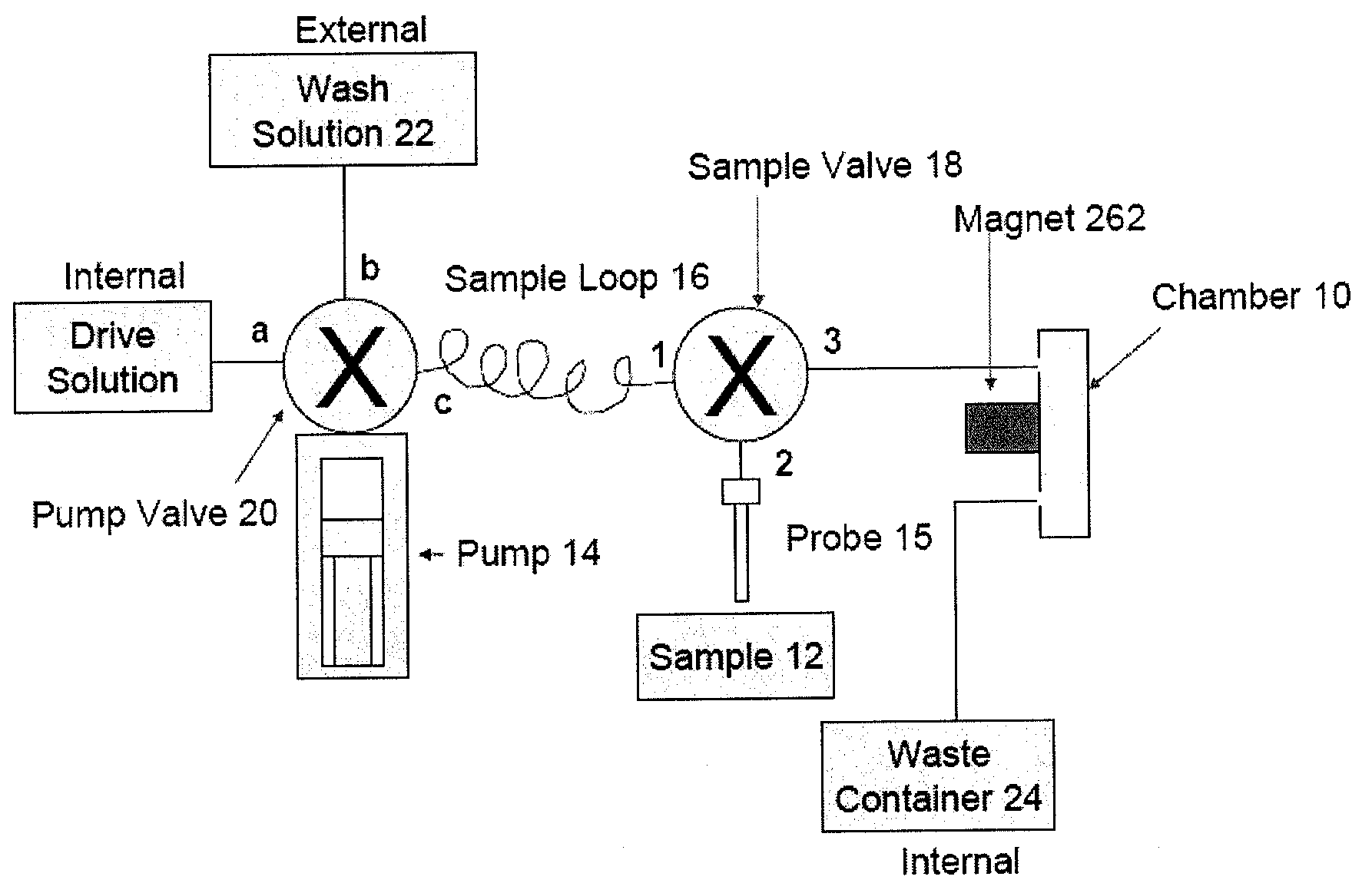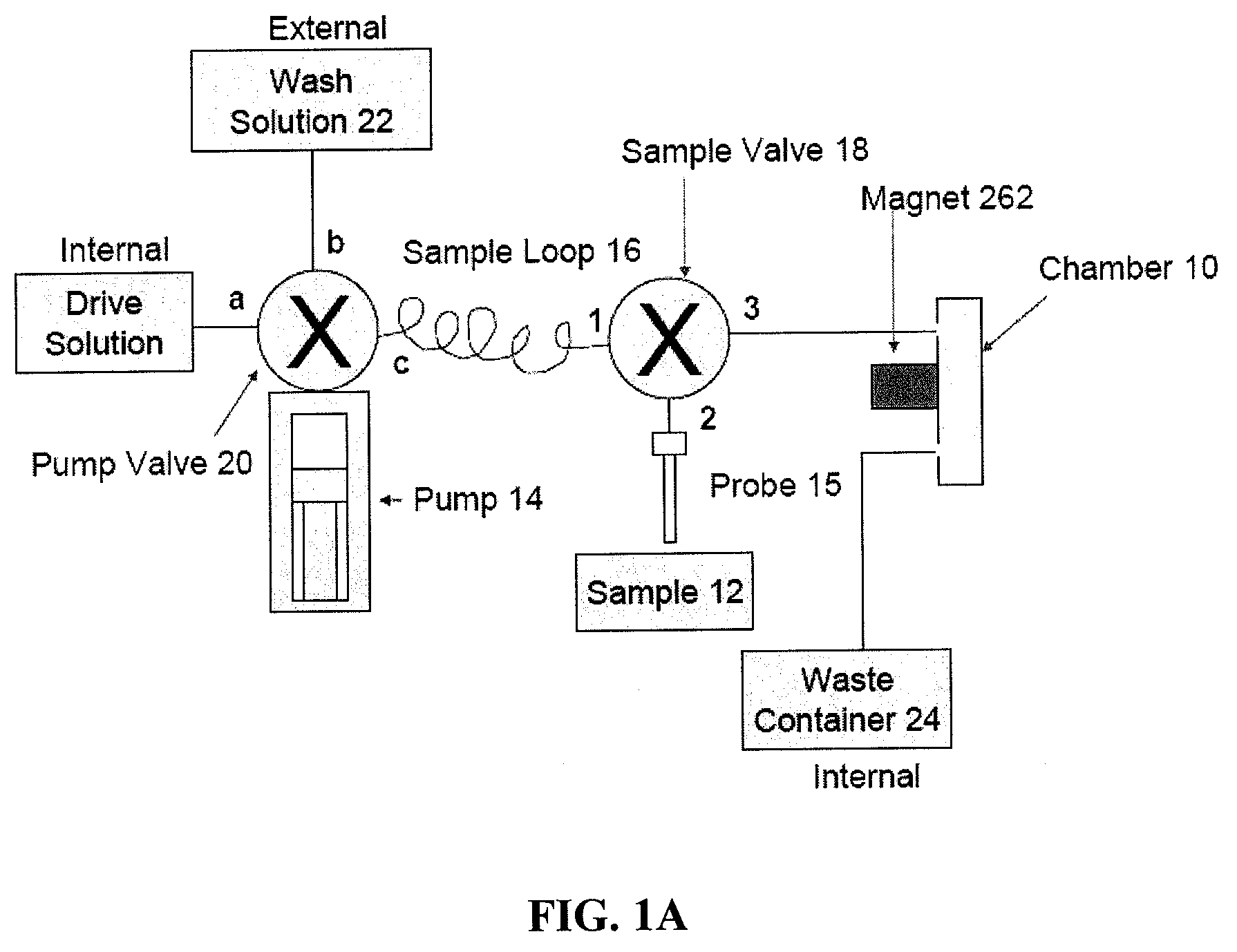Immunomagnetic capture and imaging of biological targets
a biological target and imaging technology, applied in the field of biological analytes detection, can solve the problems of lack of sample preparation automation, lack of integrated apparatus that would perform all the analysis steps, and lack of integration around the compact imaging chamber
- Summary
- Abstract
- Description
- Claims
- Application Information
AI Technical Summary
Benefits of technology
Problems solved by technology
Method used
Image
Examples
example 1
Enumeration of CD4 Cells
[0409]In this example the magnetic capturing antibody is an Anti-CD4 antibody that captures all CD4 lymphocytes as well as all CD4 monocytes. The detecting antibody is the same or another anti-CD4 antibody conjugated with a fluorescent label. The real-time analysis process monitors the population of CD4 cells present in the imaging chamber. At the end of the sample loading step, all enumerated CD4 cells will correspond to all CD4 lymphocytes and CD4 monocytes captured by the capturing antibody and labeled by the detecting antibody.
[0410]A sample of whole blood is collected and stored in a BD Vacutainer containing 2 mM EDTA as anticoagulant (BD Biosciences #366452). 20 μL of the sample is pipeted into a 1.5 mL centrifuge tube. 5 μL of Magnetic Anti-CD4 capturing Antibody (IMag™ Anti-human CD4 particles—BD Biosciences Cat#: 557767) are directly added to the centrifuge tube containing the 20 μL of blood sample. 5 μL of phycoerythrin (PE) labeled Anti-CD4 detecti...
example 2
Enumeration of CD4 Lymphocytes by Subtractive Strategy
[0412]In this example the magnetic capturing antibody is an anti-CD4 antibody that captures all CD4 lymphocytes as well as all CD4 monocytes. The cocktail of detection antibodies will include an anti-CD4 antibody conjugated with one fluorescent label (Label 1), and an anti-CD14 antibody conjugated to another fluorescent label (Label 2). The real-time analysis process will monitor the population of CD4 cells present in the imaging chamber. At the end of the sample loading step, all enumerated CD4 cells will correspond to all CD4 lymphocytes and CD4 monocytes captured by the capturing antibody and present in the sample. All enumerated CD14 cells will correspond only to the population of monocytes captured by the capturing antibody and present in the sample. The count of CD4 lymphocytes is calculated by deduction of the monocytes count from the total CD4 count.
[0413]A sample of whole blood is collected and stored in a BD Vacutainer ...
example 3
Measurement of Clinically Relevant Counts of CD3 Cells, CD4 Cells, and CD8 Cells
[0415]In this example the magnetic capturing antibody is an anti-CD3 antibody that captures all lymphocytes. The cocktail of detection antibodies includes an anti-CD3 antibody conjugated with one fluorescent label (Label 1), and an anti-CD4 antibody conjugated to another fluorescent label (Label 2) and an anti-CD8 antibody conjugated to a third fluorophore (Label 3). The real-time analysis process monitors the population of CD3 cells present in the imaging chamber. FIG. 7 illustrates the imaging systems field of view using the “Label 1” detection channel, which detects the CD3 population (i.e., all lymphocytes), at time points T1, T2, . . . Tn, and Tfinal. Detection and enumeration of the captured cells is repeatedly performed until the imaging processing algorithm enumerates a number of cells above a certain threshold. Once the number of cells in the field of view reaches the defined threshold, the samp...
PUM
 Login to View More
Login to View More Abstract
Description
Claims
Application Information
 Login to View More
Login to View More - R&D
- Intellectual Property
- Life Sciences
- Materials
- Tech Scout
- Unparalleled Data Quality
- Higher Quality Content
- 60% Fewer Hallucinations
Browse by: Latest US Patents, China's latest patents, Technical Efficacy Thesaurus, Application Domain, Technology Topic, Popular Technical Reports.
© 2025 PatSnap. All rights reserved.Legal|Privacy policy|Modern Slavery Act Transparency Statement|Sitemap|About US| Contact US: help@patsnap.com



